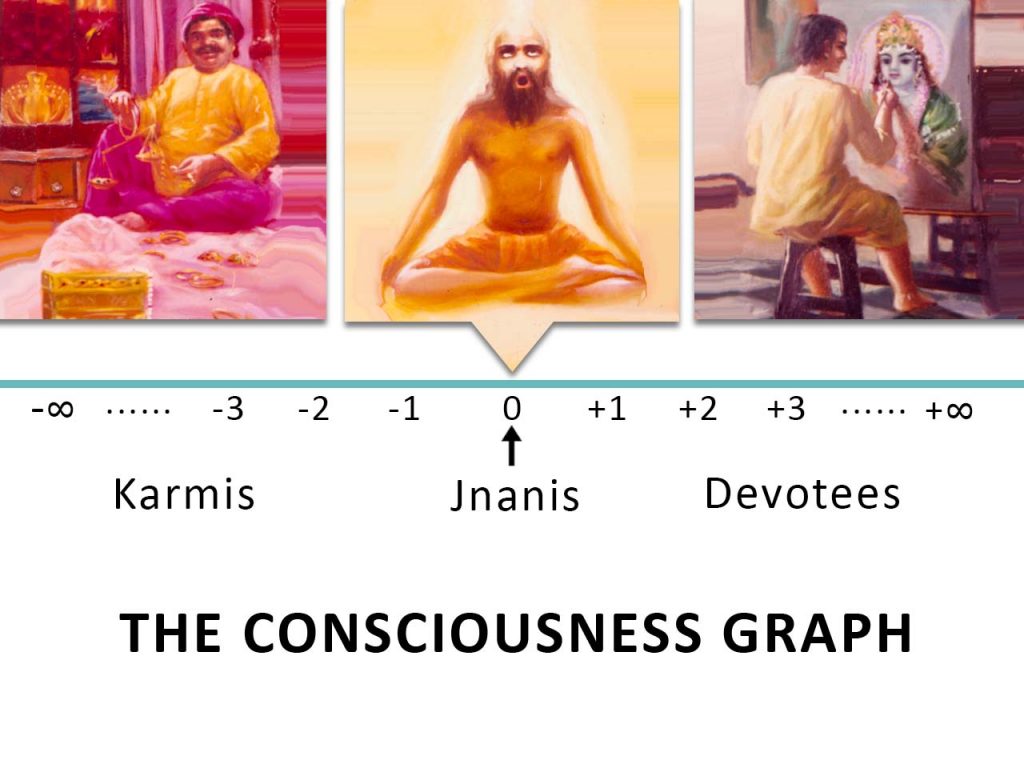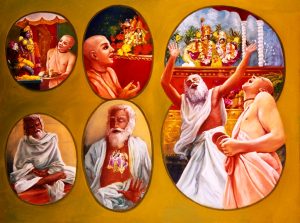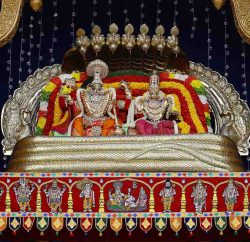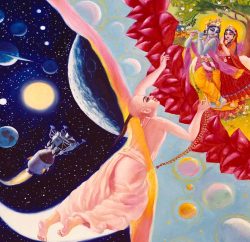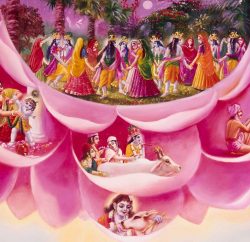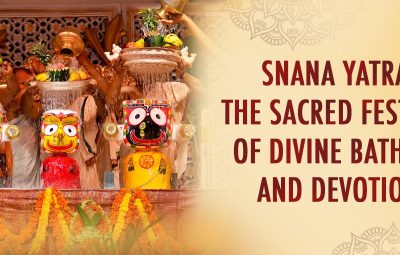Do you remember your progressive learning of mathematics in your childhood days? When we were in standard 1 or 2, we all learnt numbers starting from 1 and later 0 was introduced. We had no idea about negative numbers. When we came to standard 5, the concept of negative numbers was introduced through a number line.
Table of Contents
This graph of number line can be compared with the graph of our consciousness.
As shown in the graph above, there are broadly three types of consciousness – that of karmis, jnanis and devotees.
The karmi consciousness is on the negative side. The consciousness of the jnanis is at 0. The positive consciousness on the right side is called Krishna consciousness and devotees are of this positive consciousness. The negative side of the graph represents the material world and the positive side indicates the spiritual world.
The karmis or fruitive workers are those who are trying to enjoy the material platform by always being engaged in materialistic activities. Jnanis are the philosophers and mental speculators, who are inclined towards understanding the ultimate truth by way of their own logic and reasoning. And the devotees are those who are engaged in the service of the Supreme Lord in His personal feature.
Karmis on the Negative Side
Generally, people are engrossed in the bodily concept of life with very little or no knowledge about the soul. They are attached to doing materialistic activities for varieties of sense enjoyment. They work hard for improving their economic condition in order to better fulfil the demands of their senses. Sometimes they take to religiosity and perform ritualistic ceremonies as well as pious activities desiring to get rid of their miseries or to attain sensual pleasures in the future. Such persons are unaware of the fact that the so-called happiness they are trying to experience is only illusory. It is temporary and also the source of so many miseries. Such karmis who are not interested in spiritual life fall on the negative side of the graph.
Material Word – A reflection of Vaikuntha
If there is minus infinity, there is also a positive infinity. Similarly, the material world is a perverted reflection of the spiritual world. It is only a shadow of Vaikuntha. The variety of forms, activities, relationships, etc. that we see in the material world are originally present in Vaikuntha in its perfection. They are all eternal and blissful. In the material world, variety may be a source of all sorts of miseries. But what is miserable in the material world is actually pleasurable in the spiritual world.
Sugarcane or Bamboo Sticks?
Once, a foolish man who had no experience of the taste of sugarcane was informed that it was very sweet. But he did know how the sugarcane looked like. Then someone said that it looked just like a bamboo stick. So the foolish man began to chew all kinds of bamboo sticks and naturally failed in his attempt to taste sugarcane. Similarly, the fruitive worker has no knowledge of the real happiness available in the Vaikuntha. He goes on trying out in different ways to get pure and eternal happiness in this world but is frustrated in his attempts.
Impersonalists and Voidists at Zero
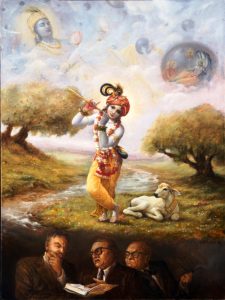 Some of the fruitive workers who are baffled in their attempt to enjoy sense gratification and who repeatedly experience miseries, develop a tendency to give up all material activities considering them to be sources of misery. In the material world, there exist varieties of forms, persons, activities and relationships. And the material bodies are perishable, full of ignorance and completely miserable. Therefore such persons negate all variegatedness in the Supreme Truth, the source of all pleasure and conclude that it must be without form, qualities and activities. They are called impersonalists and are situated at 0 (zero) in the graph. For them, it is almost impossible to understand the personal nature of the Supreme Absolute Truth who has a transcendental body which is imperishable, full of knowledge and eternally blissful. They think that the Supreme Truth is impersonal and the thought of retaining the personality after liberation from material existence frightens them. So they prefer a kind of merging into the impersonal void like the merging of the bubbles of an ocean into the ocean. That is the highest perfection of spiritual existence attainable without individual personality. This is a kind of fearful stage of life, devoid of perfect knowledge of spiritual existence.
Some of the fruitive workers who are baffled in their attempt to enjoy sense gratification and who repeatedly experience miseries, develop a tendency to give up all material activities considering them to be sources of misery. In the material world, there exist varieties of forms, persons, activities and relationships. And the material bodies are perishable, full of ignorance and completely miserable. Therefore such persons negate all variegatedness in the Supreme Truth, the source of all pleasure and conclude that it must be without form, qualities and activities. They are called impersonalists and are situated at 0 (zero) in the graph. For them, it is almost impossible to understand the personal nature of the Supreme Absolute Truth who has a transcendental body which is imperishable, full of knowledge and eternally blissful. They think that the Supreme Truth is impersonal and the thought of retaining the personality after liberation from material existence frightens them. So they prefer a kind of merging into the impersonal void like the merging of the bubbles of an ocean into the ocean. That is the highest perfection of spiritual existence attainable without individual personality. This is a kind of fearful stage of life, devoid of perfect knowledge of spiritual existence.
And there are voidists, who are bewildered by so many theories about the ultimate truth and the contradictions of different philosophical speculations. They become frustrated or angry and conclude that there is no supreme cause and that everything is ultimately void.
Ignorance of Healthy Life
Suppose a patient, who is sick since his birth, is lying in the hospital and cannot walk freely or cannot eat delicious foods. He takes only bitter medicines and injections. If someone tells him that he could lead a healthy life after he gets cured and eat tasty dishes, he will not believe it. He remarks, “Again eating? Oh, it is horrible,” because he has no experience of eating in a healthy condition. Similarly, the impersonalist or voidist has no understanding of the spiritual forms, activities, relationships, etc. in the Vaikuntha.
Zero is Only the Beginning of Mukti
Mukti or liberation means freedom from material consciousness. In the Srimad-Bhagavatam (2.10.6), mukti is defined as muktir hitvānyathā-rūpaṁ svarūpeṇa vyavasthitiḥ – mukti means liberation from the contaminated consciousness of this material world and situation in pure consciousness.
In the conscious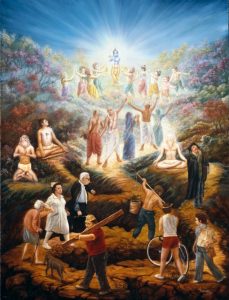 ness graph, the negative side is to be in the material world. The next stage is to get out of the negative side, i.e, material consciousness and to come to zero. It is the stage of pure consciousness. But it is only the beginning of mukti.
ness graph, the negative side is to be in the material world. The next stage is to get out of the negative side, i.e, material consciousness and to come to zero. It is the stage of pure consciousness. But it is only the beginning of mukti.
The jnanis think that attaining zero is the ultimate stage of liberation and any kind of description of variety means misery because they have the experience of only the negative side. But one who is truly intelligent knows that if there are negative numbers, there are also positive numbers as in the above graph. Such intelligent people are called devotees.
Lord Krishna says in the Bhagavad Gita (10.8)
ahaṁ sarvasya prabhavo
mattaḥ sarvaṁ pravartate
iti matvā bhajante māṁ
budhā bhāva-samanvitāḥ
“I am the source of all spiritual and material worlds. Everything emanates from Me. The wise who know this perfectly engage in My devotional service and worship Me with all their hearts.”
Devotees on the Positive Side
Lord Krishna says in the Bhagavad Gita (4.10)
vīta-rāga-bhaya-krodhā
man-mayā mām upāśritāḥ
bahavo jñāna-tapasā
pūtā mad-bhāvam āgatāḥ
“Being freed from attachment, fear and anger, being fully absorbed in Me and taking refuge in Me, many, many persons in the past became purified by knowledge of Me-and thus they all attained transcendental love for Me.”
Thus, one has to get rid of all three stages of attachment to the material world: negligence of spiritual life due to material attachment, fear of a spiritual personal identity, and the conception of void out of frustration and come to the positive side of the graph where devotees are situated.
Positive side is the spiritual world. As discussed in the previous article, there are unlimited Vaikuntha planets with varieties of features which are all on the positive side. The liberation or mukti as understood by the impersonalists or jnanis is only the point of zero but there are different types of mukti or liberation which exist on the positive side.
Let us see what are the types of mukti in our next article.
Related Links : Five things to do on Vaikuntha Ekadashi| Why do we celebrate Vaikuntha Ekadashi | Why Vaikuntha series | Sri Vaikuntha Ekadashi


